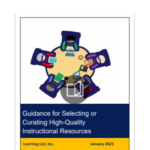
Over the years, Learning List has assisted hundreds of districts in planning and running K-12 curriculum adoptions. As a result, we have observed many “what to do’s” and “what not to do’s.” One of the critical “to-do’s” is to plan the process. A well-planned, thorough process is far more likely to lead to a successful outcome.
Some important decision points to consider as you plan an K-12 curriculum adoption process include:
(1) Articulate the need to adopt a new K-12 curriculum: To ensure buy-in for a newly selected material, teachers, campus administrators, the school board, and the community should understand why the district or campus needs to purchase new materials now.
(2) Define the non-negotiables for the adoption: The non-negotiables are the basic requirements for the new material, such as budget/price limit, minimum alignment percentage, instructional model, required supports for students, and required resources for teachers. Involve the district or campus leadership, as appropriate, in defining the non-negotiables.
(3) Establish a timeline: Working back from the date of the school board meeting when the new K-12 curriculum will be adopted, construct a timeline that provides sufficient time for the selection committee and the community to review the materials, the selection committee to deliberate and make recommendations to the school board, for the board to adopt the materials, and for the materials to be distributed to the teachers and students. Keep in mind that teachers need to receive the new materials with sufficient time to participate in professional development and plan lessons using the new material before the school year begins.
(4) Document the review process logistics: To make sure that the reviews will be conducted in a uniform manner within the prescribed timeline, all selection committee members and the community need to know:
- When, where, and for how long the materials will be available for review
- How the reviews will take place (virtually or in-person), and if the reviews will be conducted virtually, where login credentials for each material will be available
- Whether publisher presentations will be permitted, and if so, when and where will those presentations take place
- Whether a rubric has been developed for the review process and if so, when it will be distributed
- How and when reviewers’ responses must be submitted and to whom
- Voting protocols for committee deliberations
- Distribution and implementation logistics
(5) Identify the Selection Committee Makeup: State law and/or school board policy may dictate the positions that must be represented on the selection committee. Generally speaking, the committee should consist of a representative sample of teachers who will be using the material and staff who will be supporting its implementation. Both experienced and inexperienced teachers should participate. In addition to the makeup of the committee, it is important to document attendance requirements and how selection committee members will be replaced if they are unable to meet those requirements.
Learning List’s Selection Toolkit provides customizable planning documents, including a Decision Tree document that ensures that all key decision points are considered, and a Timeline document that helps to backward design the selection process.
Read our free, publicly available whitepaper titled, Guidance for Selecting or Curating High-Quality Instructional Resource, for more detailed information and step-by-step guidance for planning and implementing a K-12 curriculum review and adoption process efficiently and effectively.
